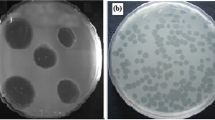Abstract
Pseudomonas aeruginosa, a human pathogen capable of forming biofilm and contaminating medical settings, is responsible for 65% mortality in the hospitals all over the world. This study was undertaken to isolate lytic phages against biofilm forming Ps. aeruginosa hospital isolates and to use them for in vitro management of biofilms in the microtiter plate. Multidrug resistant strains of Ps. aeruginosa were isolated from the hospital environment in and around Pimpri-Chinchwad, Maharashtra by standard microbiological methods. Lytic phages against these strains were isolated from the Pavana river water by double agar layer plaque assay method. A wide host range phage bacterial virus Ps. aeruginosa phage (BVPaP-3) was selected. Electron microscopy revealed that BVPaP-3 phage is a T7-like phage and is a relative of phage species gh-1. A phage at MOI-0.001 could prevent biofilm formation by Ps. aeruginosa hospital strain-6(HS6) on the pegs within 24 h. It could also disperse pre-formed biofilms of all hospital isolates (HS1–HS6) on the pegs within 24 h. Dispersion of biofilm was studied by monitoring log percent reduction in cfu and log percent increase in pfu of respective bacterium and phage on the peg as well as in the well. Scanning electron microscopy confirmed that phage BVPaP-3 indeed causes biofilm reduction and bacterial cell killing. Laboratory studies prove that BVPaP-3 is a highly efficient phage in preventing and dispersing biofilms of Ps. aeruginosa. Phage BVPaP-3 can be used as biological disinfectant to control biofilm problem in medical devices.




Similar content being viewed by others
References
Lakkis C, Flesszig SMJ (2001) Resistance of Pseudomonas aerugonisa isolates to hydrogel contact lens disinfection correlates with cytotoxic. Activ Clin Microbiol 39:1477–1486
Mehta M, Punia JN, Joshi RM (2001) Antibiotic resistance in Pseudomonas aeruginosa strains isolated from various clinical specimens—a retrospective study. Indian J Med Microbiol 19:232
Philippe E, Weiss M, Shultz JM, Yeomanas F, Ehrenkranz NJ (1999) Emergence of highly antibiotic resistant Pseudomonas aeruginosa in relation to duration of empirical antipseudomonal antibiotic treatment. Clin Perform Qual Health Care 7:77–83
Sillankorva S, Oliverira R, Viveira MJ, Sutherland I, Azeredo J (2004) Pseudomonas Fluorescens infection by bacteriophage PhiSI: the influence of temperature host growth phase and media. FEMS Microbiol Lett 241:13–20
Stickler DJ, Morris NS, Mclean RJ, Fuqua C (1998) Biofilms on indwelling urethral catheters produce quorum sensing single molecules in situ and in vitro. Appl Environ Microbiol 64:3486–3490
Matthew KW, David IF, Sankar LA (2005) Phages: their role in bacterial pathogenesis and pathogenecity. ASM Press, Washington, pp 430–440
Fox J (2000) Phage treatments yield healthier tomato, pepper plants. ASM News 66:455–456
Barrow P, Lovell M, Berchieri A (1998) Use of Lytic lytic bacteriophage for control of experimental Escherichia coli septicemia and meningitis in chickens and calves. Clin Diagn Lab Immunol 5:294–298
Biswas B, Adhya S, Washart P, Paul B, Trostel AN, Powell B et al (2002) Bacteriophage therapy rescues mice bacteremic from clinical isolate of vancomycin resistant Enterococcus faecium. Infect Immun 70:704–710
Bonfiglio G, Carciotto V, Russo G, Stefani S, Schito GC, Debbia E et al (1998) Antibiotic resistance in Pseudomonas aeruginosa: an Italian survey. J Antimicrob Chemother 20:263–269
Cerca N, Oliveira R, Azeredo J (2007) Susceptibility of Staphylococcus epidermidis plan tonic cells & biofilms to the lytic action of staphylococcus bacteriophage K. Lett Appl Microbiol 45:313–317
Curtin JJ, Donlan RM (2006) Using bacteriophages to reduce formation of catheter-associated biofilms by Staphylococcus epidermidis. Antimicrob Agents Chemother 50:1268–1275
Timothy KL, James JC (2007) Dispersing biofilms with engineered enzymatic bacteriophage. Proc Natl Acad Sci USA 104:11197–11202
Bedi MS, Verma V, Chhibber S (2009) Amoxicillin & specific bacteriophage can be used together for eradication of biofilm of Klebsiella pneumoniae B 5055. World J Microbiol Biotechnol 25:1145–1151
Godkar P, Godkar DP (2003) Medial laboratory technology, 2nd edn. Bhalani Published House, Mumbai, pp 557–568
Adams MH (1959) Bacteriophages. Interscience, New York
Hanlon GW, Denyser SP, Olliff CJ, Ibrahim LJ (2001) Reduction of exopolysaccharide viscosity as an aid to bacteriophage penetration through Pseudomonas aeruginosa biofilms. Appl Environ Microbiol 67:2746–2753
Knezevic P, Petrovic O (2008) A colorimetric microtiter plate method for assessment of phage effect on Pseudomonas aeruginosa biofilm. J Microbiol Meth 7:114–118
Acknowledgments
Special thanks to University of Pune authorities for providing financial assistance, and Sangeeta Ahiwale thanks the principal, Mahatma Phule College, Pimpri for encouragement and laboratory facilities.
Author information
Authors and Affiliations
Corresponding author
Rights and permissions
About this article
Cite this article
Ahiwale, S., Tamboli, N., Thorat, K. et al. In Vitro Management of Hospital Pseudomonas aeruginosa Biofilm Using Indigenous T7-Like Lytic Phage. Curr Microbiol 62, 335–340 (2011). https://doi.org/10.1007/s00284-010-9710-6
Received:
Accepted:
Published:
Issue Date:
DOI: https://doi.org/10.1007/s00284-010-9710-6




